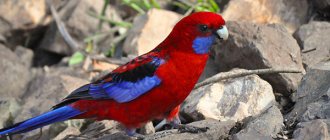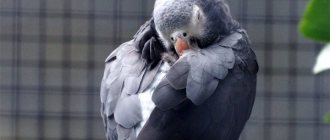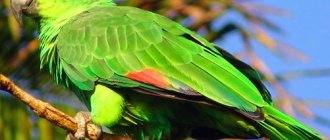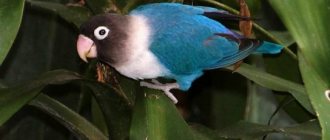In the mountains of New Zealand lives a unique bird - the kea parrot. Its scientific name is nestor (from the Latin Nestor notabilis). Local residents gave him the nickname “Sheep killer,” that is, “sheep killer.” What is this connected with, and why did Nestor get a bad reputation? After reading the article, you will find the answers and also get an idea about the appearance, lifestyle and habits of the parrot. In addition, you will learn about the reproductive characteristics and conservation status of kea.
Appearance
The New Zealand mountain parrot kea is also called nestor (Nestor Notabilis). The local name is “speaking”: “Sheep killer” - “sheep killer”. It is completely different from other parrots, more reminiscent of a raven or falcon.
The external features of the bird are as follows:
| Characteristic | Description |
| Height | Up to 50 cm |
| Weight | About 1kg |
| Plumage color | Olive and brown on top. From the “wrong side” the wings are bright orange with blue stripes |
| Legs | Strong, gray |
| Beak | Dark grey, sharp. The top part is twice as long as the bottom |
| Iris | Dark, almost black |
Strong paws help the Nestor parrot to hold firmly on any surface and move quickly. The beak can also be called a limb, because it is involved in almost all tricks. By the way, unlike the female, the male has a larger beak.
As you can see in the photo, in young kea parrots the area around the eyes and part of the beak are colored yellow.
Do you know why this species of parrot was called kea? Thanks to the sound they make in flight: a drawn-out “ke-e-a-a!”
In this video you can hear how kea does this, and also watch his tricks:
When a kea spreads its wings and begins to soar above the ground, it is an amazingly beautiful sight. The parrot's body begins to shimmer and play with different shades and colors, which are almost invisible when the bird's wings are folded.
Kea parrot hovering
Features of reproduction
The age of sexual maturity in kea occurs at three years. A young female is courted by an established, experienced male. The mating season lasts from July to December. After creating a married couple, parrots look for a suitable nesting place in rock crevices. Having chosen a hole up to 6 meters deep so that the chicks are reliably protected, the female immediately begins to build a nest. Having prepared, the female lays 4–6 eggs and incubates them for three weeks.
The male kea is a very caring family man. Despite polygamy, he pays attention to each of his females, and there are 2–4 of them. During incubation, he carries food and protects the home from the penetration of enemies. Newborn chicks are raised together with their partner. The offspring remains in the nest for 3–4 months, the female leaves, and the father continues to feed the growing cubs.
Character and intelligence
Kea parrots are known for their wild temperament. It’s not for nothing that local residents consider them a real disaster. Birds fly into houses, clean up trash cans, raid cars, and break or tear off windshield wipers. They also like to steal food from unwary tourists from backpacks and directly from their hands. They are not afraid of people at all.
Keas are rightfully considered the smartest birds. They are superior in intelligence to ravens. They are also smarter than primates. The list of their abilities looks like this:
- solve simple puzzles;
- easily cope with color tasks;
- perform simple work;
- open the locks.
Watch this video for an example of the intellectual abilities of a kea parrot:
Birds are easy to train and quickly get used to people. For this reason, many parrot lovers want to keep such unusual and intelligent birds at home.
Tastes could not be discussed
It must be said that kea is a bird with a truly unusual taste. The parrot became the hero of numerous New Zealand legends not only because of its addiction to sheep fat, but also because of its uncontrollable craving for rubber. Moreover, rubber gaskets for car windows are especially popular. A parrot can torment this “delicacy” even while the car is moving, and in order to get rid of the intrusive passenger, drivers increase the speed. One day, a careless motorist left his car on the street overnight. In the morning, he hardly recognized his iron horse - a flock of robbers completely ate the rubber gasket of the windshield, as a result, it simply collapsed inside the car! And since these birds do not disdain foam rubber, they tore all the car seats to shreds, and then started working on the interior trim!
How the kea parrot hunts sheep
As stated above, kea did not eat meat. Their diet changed with the arrival of Europeans, who raised livestock, modified the landscape to suit their needs, and hunted wild animals. It became increasingly difficult for the parrots to find their usual food. But they got the corpses of deer or dead sheep left in the forest. Then their main delicacy became fat from skins or meat waste.
Over time, kea parrots began to attack sick or old sheep. Until a certain time, farmers were not very concerned about the current situation. But at some point the birds began to prey on young and healthy livestock.
The hunt looks something like this:
- the parrot sits on the grass not far from the lagging animal;
- jumps on the sheep's back;
- With its strongly curved and sharp beak, the kea pulls out tufts of fur, gradually reaching the skin.
Feeling pain, the animal tries to throw the bird off and run away. At this moment the parrot pecks at the wound and eats the fat. Due to fear and pain, the sheep can no longer navigate the terrain. She dies by falling off a cliff or losing a lot of blood.
Proper nutrition
Since birds live in difficult conditions, this creates certain difficulties associated with finding food. Therefore, parrots were forced to become predators, since in winter they have to hunt small animals and even sheep.
The diet includes the following products:
- flowers, fruits, vegetables and herbs;
- nuts;
- worms;
- bird eggs;
- small chicks;
- waste remaining from human activity;
- meat of various animals.
Previously, kea were not predatory animals, so they ate exclusively plant foods, but the lack of food in winter led to a significant change in the parrots’ lifestyle.
Conservation status of the species
Until 1970, when kea received protected status, the population was on the verge of extinction. This is due to their attacks on livestock. Although they did not cause much damage, their hunting of sheep caused a storm of indignation among farmers. They, in turn, asked the hunters to shoot the annoying birds. Over 150 years, more than 100,000 nestors were killed.
In 1970, a law was passed to protect kea. However, for another 15 years their lives were in danger. The situation stabilized only after the government began to compensate for the loss of dead livestock.
It is worth noting that hunters are not the only threat to nestor birds. Population decline is also caused by:
- death under the wheels of vehicles;
- mammal attacks;
- death in power plants;
- ingestion of pieces of lead into the body;
- death under garbage cans;
- change in climatic conditions.
Now kea parrots are listed in the International Red Book. They are also mentioned in the Convention on International Trade in Endangered Species of Wild Flora and Fauna.
As of 2021, there were more than 6,000 nestor parrots living in New Zealand.
Life in natural conditions
A large number of these parrots can be found in New Zealand, and the birds rarely fly to other countries. They live in flocks of 15 individuals, since this way of life greatly simplifies the process of protecting themselves from predators and finding food. They easily survive even in harsh conditions, so they do not die in strong winds, snow storms or fog.
Local residents watch in amazement as the parrot swims in puddles or tumbles in the snow in winter . They often roll off snow-covered roofs. In the wild, birds usually live no more than 15 years, but if optimal conditions are created in captivity, they can live up to 50 years.
It is also useful to read: Amazon parrot
Smarter than monkeys
For many decades, ornithologists have considered parrots to be the smartest birds. They learn easily, can solve logic problems, distinguish colors and are famous for their good memory. Repeated studies have shown that only kea parrots can fully cope with tests of intelligence. Even monkeys, considered the most intelligent mammals, cannot complete some of the tasks proposed by scientists.
Researchers call the ability to imitate their relatives another proof of the high mental abilities of the “mountain clowns.” Watching other birds helps New Zealand parrots learn new skills and duplicate the behavior of crows, wrens, ospreys and other birds.
It is the intelligence of these parrots that makes it possible to turn a feathered predator into an affectionate domestic animal. Attempts to domesticate savvy thieves by many residents of Yuzhny Island have been successful. Perhaps only the steel bars of the cage can keep the predatory kea parrots from theft, hooliganism and vandalism.
Range, habitats
The kea is recognized as endemic to New Zealand, as it lives exclusively in the highlands of the South Island (above the forest zone). The species has adapted well to snowy winters, preferring harsh climates to subtropical warmth. Keas are not afraid of spring fogs and strong summer winds; they are accustomed to winter frosts and blizzards.
Kea live in mountains, beech forests and valleys with steep wooded slopes, periodically descending into alpine meadows and exploring bush thickets. Parrots are not afraid of humans, so they often settle near campsites, hotels, tourist complexes and houses.











